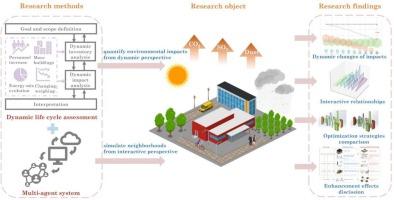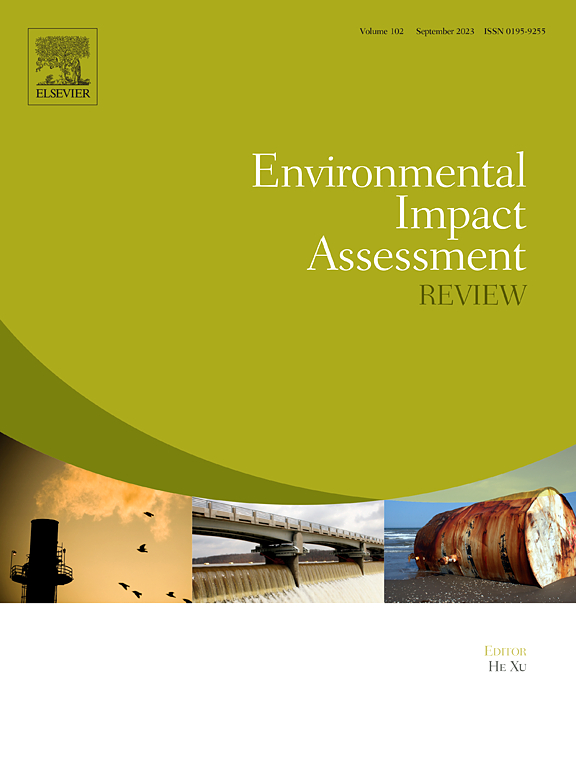Interactive and dynamic insights into environmental impacts of a neighborhood: A tight coupling of multi-agent system and dynamic life cycle assessment
IF 9.8
1区 社会学
Q1 ENVIRONMENTAL STUDIES
引用次数: 0
Abstract
Neighborhoods consume large amount of energy and generate substantial pollutant emissions worldwide, and assessment of the environmental impacts (EIs) has garnered particular attention. Nevertheless, the traditional life cycle assessment (LCA) method fails to account for the local variability in non-homogeneous systems due to spatiotemporal dynamics and interactions. Hence, this study integrated the multi-agent system (MAS) with the dynamic LCA (DLCA) model to develop an intelligent EIs assessment model at the neighborhood scale from an interactive and dynamic perspective. MAS was employed to simulate the interactions in neighborhoods and generate foreground elementary flow data considering dynamics. DLCA provides an impact assessment framework. The proposed model was applied to a university campus to demonstrate its operability, and the enhancement effectiveness of integrating MAS with DLCA can be observed. The interactions among the climate, people, and built environment agents on the campus were simulated.10 temporal dynamic factors and four kinds of case-specific dynamic parameters were considered. The effects of several optimization strategies were simulated, and valuable directions, like raising energy conservation awareness, regulating public devices, and improving the campus layout, were proposed. This study established a comprehensive integrated MAS-DLCA model at the neighborhood scale, providing a methodology and practical application process for future studies. It can be used to promote green neighborhood management and sustainable city practices.

以互动和动态的方式深入了解社区对环境的影响:多代理系统与动态生命周期评估的紧密结合
在全球范围内,居民区消耗大量能源并产生大量污染物排放,因此环境影响(EIs)评估受到特别关注。然而,传统的生命周期评估(LCA)方法无法考虑非均质系统中由于时空动态和相互作用而产生的局部变化。因此,本研究将多代理系统(MAS)与动态生命周期评估(DLCA)模型相结合,从交互和动态的角度开发了邻域尺度的智能环境影响评估模型。MAS 被用来模拟邻里间的互动,并生成考虑到动态性的前景基本流数据。DLCA 提供了一个影响评估框架。为了证明模型的可操作性,将 MAS 与 DLCA 相结合,可以观察到模型的增强效果。模拟了校园内气候、人员和建筑环境因子之间的相互作用。模拟了几种优化策略的效果,提出了提高节能意识、调节公共设备和改善校园布局等有价值的方向。本研究建立了街区尺度的综合 MAS-DLCA 模型,为今后的研究提供了方法论和实际应用流程。该模型可用于推广绿色街区管理和可持续城市实践。
本文章由计算机程序翻译,如有差异,请以英文原文为准。
求助全文
约1分钟内获得全文
求助全文
来源期刊

Environmental Impact Assessment Review
ENVIRONMENTAL STUDIES-
CiteScore
12.60
自引率
10.10%
发文量
200
审稿时长
33 days
期刊介绍:
Environmental Impact Assessment Review is an interdisciplinary journal that serves a global audience of practitioners, policymakers, and academics involved in assessing the environmental impact of policies, projects, processes, and products. The journal focuses on innovative theory and practice in environmental impact assessment (EIA). Papers are expected to present innovative ideas, be topical, and coherent. The journal emphasizes concepts, methods, techniques, approaches, and systems related to EIA theory and practice.
 求助内容:
求助内容: 应助结果提醒方式:
应助结果提醒方式:


